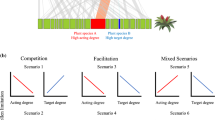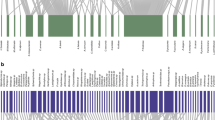Abstract
Plant–pollinator network studies have uncovered important generalities in the structure of these communities, rapidly advancing our understanding of the underlying drivers of such a structure. In spite of this, however, it is still unclear how changes in structural network properties influence overall plant pollination success. One key limitation is the lack of information on the relationship between network structural properties and aspects of pollination and plant reproductive success. Here, we estimate four plant species network structural metrics (interaction strength, weighted degree, closeness centrality, and specialization level), commonly used to describe their importance within plant–pollinator networks, at two different sites, and evaluate their effects on pollen deposition and pollen tube success. We found a positive effect of plant–pollinator specialization and a negative effect of closeness centrality on heterospecific pollen load size. We also found a marginal negative effect of closeness centrality on pollen tube success. Our results suggest that increasing plant–pollinator specialization within nested communities (pollinated by one or very few generalist insect species) may result in high levels of heterospecific pollen transfer. Furthermore, the differential effects of plant–pollinator network metrics on pollination success (pollen receipt and pollen tube success), highlight the need to integrate quantity (e.g. visitation rate) and quality (e.g. pollen delivery) aspects of pollination to achieve a more mechanistic understanding of the relationship between plant–pollinator network structure and function. Such knowledge is key to evaluate the resilience and stability of plant–pollinator communities and the services they provide in the face of increasing human disturbances.


Similar content being viewed by others
References
Aizen MA, Harder LD (2007) Expanding the limits of the pollen-limitation concept: effects of pollen quantity and quality. Ecology 88:271–281. https://doi.org/10.1890/06-1017
Arceo-Gómez G, Ashman TL (2011) Heterospecific pollen deposition: does diversity alter the consequences? New Phytol 192:738–746. https://doi.org/10.1111/j.1469-8137.2011.03831.x
Arceo-Gómez G, Ashman TL (2014) Patterns of pollen quantity and quality limitation of pre-zygotic reproduction in Mimulus guttatus vary with co-flowering community context. Oikos 123:1261–1269. https://doi.org/10.1111/oik.01309
Arceo-Gómez G, Raguso RA, Geber MA (2016) Can plants evolve tolerance mechanisms to heterospecific pollen effects? An experimental test of the adaptive potential in Clarkia species. Oikos 125:718–725. https://doi.org/10.5061/dryad.hb2bt
Arceo-Gómez G, Kaczorowski RL, Patel C, Ashman TL (2019) Interactive effects between donor and recipient species mediate fitness costs of heterospecific pollen receipt in a co-flowering community. Oecologia 189:1041–1047. https://doi.org/10.1007/s00442-019-04379-z
Ashman TL, Arceo-Gómez G (2013) Toward a predictive understanding of the fitness costs of heterospecific pollen receipt and its importance in co-flowering communities. Am J Bot 100:1061–1070. https://doi.org/10.3732/ajb.1200496
Balvanera P, Pfisterer AB, Buchmann N, He JS, Nakashizuka T, Raffaelli D, Schmid B (2006) Quantifying the evidence for biodiversity effects on ecosystem functioning and services. Ecol Lett 9:1146–1156. https://doi.org/10.1111/j.1461-0248.2006.00963.x
Bascompte J, Jordano P (2007) Plant-animal mutualistic networks: the architecture of biodiversity. Ann Rev Ecol Evol Sys 38:567–593. https://doi.org/10.1146/annurev.ecolsys.38.091206.095818
Bascompte J, Jordano P, Melian CJ, Olesen JM (2003) The nested assembly of plant-animal mutualistic networks. PNAS 100:9383–9387. https://doi.org/10.1073/pnas.1633576100
Bascompte J, Jordano P, Olesen JM (2006) Asymmetric coevolutionary networks facilitate biodiversity maintenance. Science 312:431–433. https://doi.org/10.1126/science.1123412
Bennett JM, Thompson A, Goia I, Feldmann R, Stefan V, Bogdan A, Rakosy D, Beloiu M, Biro IB, Bluemel S et al (2018) A review of European studies on pollination networks and pollen limitation, and a case study designed to fill in a gap. AoB PLANTS 10:068. https://doi.org/10.1093/aobpla/ply068
Berlow EL, Dunne JA, Martinez ND, Stark PB, Williams RJ, Brose U (2009) Simple predictions of interactions strengths in complex food webs. PNAS 106:187–191. https://doi.org/10.1073/pnas.0806823106
Bluthgen N, Menzel F, Bluthgen N (2006) Measuring specialization in species interaction networks. BMC Ecol 6:9. https://doi.org/10.1186/1472-6785-6-9
Boit A, Martinez N, Williams RJ, Gaedke U (2012) Mechanistic theory and modelling of complex food-web dynamics in Lake Constance. Ecol Lett 15:594–602. https://doi.org/10.1111/j.1461-0248.2012.01777.x
Borror DJ (1970) Peterson field guides: insects. Houghton Mifflin Company, USA
Burd M (1994) Bateman’s principle and plant reproduction: the role of pollen limitation in fruit and seed set. Bot Rev 60(83):139. https://doi.org/10.1007/BF02856594
Coux C, Rader R, Bartomeus I, Tylianakis JM (2016) Linking species functional roles to their network roles. Ecol Lett 19:762–770. https://doi.org/10.1111/ele.12612
Dafni A (1992) Pollination ecology: a practical approach. J Evol Bio 6:776
de Santiago-Hernandez MH, Marten-Rodriguez S, Lopezaraiza-Mikel M, Oyama K, Gonzalez-Rodriguez A, Quesada M (2019) The role of pollination effectiveness on the attributes of interaction networks: from floral visitation to plant fitness. Ecology 100:e02803. https://doi.org/10.1002/ecy.2803
Dormann CF, Gruber B, Frund J (2008) Introducing the bipartite package: analysing ecological networks. R News 8:8–11
Dunne JA, Williams RJ, Martinez ND (2002) Network structure and biodiversity loss in food webs: robustness increases with connectance. Ecol Lett 5:558–567. https://doi.org/10.1046/j.1461-0248.2002.00354.x
Eaton ER (2007) Field Guide to Insects of North America. Houghton Mifflin Company, USA
Evans AV (2007) National wildlife federation: field guide to insects and spiders of North America. Sterling Publishing Co., Inc., New York
Ghazoul J (2006) Floral diversity and the facilitation of pollination. J Ecol 94:295–304. https://doi.org/10.1111/j.1365-2745.2006.01098.x
Gilljam D (2015) Adaptive rewiring aggravates the effects of species loss in ecosystems. Nat Commun 6:8412. https://doi.org/10.1038/ncomms9412
Grime JP (1997) Biodiversity and ecosystem function: the debate deepens. Science 277:1260–1261. https://doi.org/10.1126/science.277.5330.1260
Ishida C, Kono M, Sakai S (2008) A new pollination system: brood-site pollination by flower bugs in Macaranga (Euphorbiaceae). Ann Bot 103:39–44. https://doi.org/10.1093/aob/mcn212
Ives AR, Carpenter SR (2007) Stability and diversity of ecosystems. Science 317:58–62. https://doi.org/10.1126/science.1133258
Kaiser-Bunbury CN, Muff S, Memmott J, Muller CB, Caflisch A (2010) The robustness of pollination networks to the loss of species and interactions: a quantitative approach incorporating pollinator behavior. Ecol Lett 13:442–452. https://doi.org/10.1111/j.1461-0248.2009.01437.x
Kaiser-Bunbury CN, Mougal J, Whittington AE, Valentin T, Gabriel R, Olesen JM, Bluthgen N (2017) Ecosystem restoration strengthens pollination network resilience and function. Nature 542:223–227. https://doi.org/10.1038/nature21071
Kearns CA (1998) Endangered mutualisms: the conservation of plant–pollinator interactions. Ann Rev Ecol Sys 29:83–112. https://doi.org/10.1146/annurev.ecolsys.29.1.83
King C (2013) Why flower visitation is a poor proxy for pollination: measuring single-visit pollen deposition, with implications for pollination networks and conservation. Met Ecol Evol 4:811–818. https://doi.org/10.1111/2041-210X.12074
Klots AB (1951) Peterson field guides: butterflies. Houghton Mifflin Company, USA
Koski MH, Meindl GA, Arceo-Gómez G, Wolowski M, LeCroy KA, Ashman TL (2015) Plant–flower visitor networks in a serpentine metacommunity: assessing traits associated with keystone plant species. Arthropod Plant Interact 9(9):21. https://doi.org/10.1007/s11829-014-9353-9
Knight TM, Steets JA, Vamosi JC, Mazer SJ, Burd M, Campbell DR, Dudash MR, Johnston MO, Mitchell RJ, Ashman TL (2005) Pollen limitation of plant reproduction: pattern and process. Annu Rev Ecol Evol Syst 36:467–497. https://doi.org/10.1146/annurev.ecolsys.36.102403.115320
Lázaro A, Gómez-Martinez C, Alomar D, Gonzalez-Estevez MA, Traveset A (2019) Linking species-level network metrics to flower traits and plant fitness. J Ecol. https://doi.org/10.1111/1365-2745.13334
Martin-Gonzalez AM (2010) Centrality measures and the importance of generalist species in pollination networks. Ecol Complex 7:36–43. https://doi.org/10.1016/j.ecocom.2009.03.008
Memmott J, Waser NM, Price MV (2004) Tolerance of pollination networks to species extinctions. Proc R Soc B 271:2605–2611. https://doi.org/10.1098/rspb.2004.2909
Memmott J, Craze PG, Waser NM, Price MV (2007) Global warming and the disruption of plant–pollinator interactions. Ecol Lett 10:710–717. https://doi.org/10.1111/j.1461-0248.2007.01061.x
Moeller DA (2004) Facilitative interactions among plants via shared pollinators. Ecology 85:3289–3301. https://doi.org/10.1890/03-0810
Morales CL, Traveset A (2008) Interspecific pollen transfer: magnitude, prevalence and consequences for plant fitness. Crit Rev Plant Sci 27:221–238. https://doi.org/10.1080/07352680802205631
Moreira-Herndandez JI, Muchhala N (2019) Importance of pollinator-mediated interspecific pollen transfer for angiosperm evolution. Ann Rev Ecol Evol Sys. https://doi.org/10.1146/annurev-ecolsys-110218-024804
Nielsen A, Bascompte J (2007) Ecological networks, nestedness and sampling effort. J Ecol 95:1134–1141. https://doi.org/10.1111/j.1365-2745.2007.01271.x
Niesenbaum RA (1999) The effects of pollen load size and donor diversity on pollen performance, selective abortion, and progeny vigor in Mirabilis jalapa (Nyctaginaceae). Am J Bot 86:261–268. https://doi.org/10.2307/2656941
Okuyama T, Holland JN (2008) Network structural properties mediate the stability of mutualistic communities. Ecol Lett 11:208–216. https://doi.org/10.1111/j.1461-0248.2007.01137.x
Olesen JM, Jordano P (2002) Geographic patterns in plant–pollinator mutualistic networks. Ecology 83:2416–2424. https://doi.org/10.1890/0012-9658(2002)083[2416:GPIPPM]2.0.CO;2
Petchey OL, McPhearson PT, Casey TM, Morin PJ (1999) Environmental warming alters food-web structure and ecosystem. Funct Nat 402:69–72. https://doi.org/10.1038/47023
Quinn GP, Keough MJ (2002) Experimental design and data analysis for biologists. Cambridge University Press, Cambridge
Ramos-Jiliberto R, Valdovinos FS, de Espanes PM, Flores JD (2012) Topological plasticity increases robustness of mutualistic networks. J Anim Ecol 81:896–904. https://doi.org/10.1111/j.1365-2656.2012.01960.x
SAS (2010) SAS/IML software, version 9.4 SAS Institute, Cary, North Carolina, USA
Snow AA, Spira TP (1991) Differential pollen-tube growth rates and nonrandom fertilization in Hibiscus moscheutos (Malvaceae). Am J Bot 78:1419–1426. https://doi.org/10.2307/2445280
Srivastava DS, Vellend M (2005) Biodiversity-ecosystem function research: is it relevant to conservation? Ann Rev Ecol Evol Sys 36:267–294. https://doi.org/10.1146/annurev.ecolsys.36.102003.152636
Thebault E, Fontaine C (2010) Stability of ecological communities and the architecture of mutualistic and trophic networks. Science 329:853–856. https://doi.org/10.1126/science.1188321
Tylianakis JM, Tscharntke T, Lewis OT (2007) Habitat modification alters the structure of tropical host-parasitoid food webs. Nature 445:202–205. https://doi.org/10.1038/nature05429
Tylianakis JM, Laliberte NA, Bascompte J (2010) Conservation of species interaction networks. Biol Conserv 143:2270–2279. https://doi.org/10.1016/j.biocon.2009.12.004
Valdovinos FS (2019) Mutualistic networks: moving closer to a predictive theory. Ecol Lett 22:1517–1534. https://doi.org/10.1111/ele.13279
Vanbergen AJ (2013) Threats to an ecosystem service: pressures on pollinators. Front Ecol Envir 11:251–259. https://doi.org/10.1890/120126
Vasquez DP (2012) The strength of plant–pollinator interactions. Ecology 93:719–725. https://doi.org/10.1890/11-1356.1
Weakley AS, Ludwig JC, Townsend JF (2012) Flora of Virginia Botanical Research. Institute of Texas Press, USA
Weller SG, Ornduff R (1989) Incompatibility in Amsinckia grandiflora (Boraginaceae): distribution of callose plugs and pollen tubes following inter- and intramorph crosses. Am J Bot 76:277–282. https://doi.org/10.1002/j.1537-2197.1989.tb11310.x
Acknowledgements
The authors thank the editor and two anonymous reviewers for their helpful comments on this manuscript. The authors also thank J. Donaldson for aid with plant identification and C. Patel for help with data and sample collection in the field. We thank M. Crockett for help with identifying study sites. This work was funded by an East Tennessee State University research and development grant. This article does not contain any studies with human participants or animals performed by any of the authors.
Author information
Authors and Affiliations
Contributions
GAG wrote the manuscript, GAG, DB and AS analyzed the data, TW identified insects, all authors contributed to data collection, manuscript editing and conceptualization of the ideas.
Corresponding author
Ethics declarations
Conflict of interest
The authors declare that they have no conflict of interest.
Additional information
Communicated by Monica Geber.
Electronic supplementary material
Below is the link to the electronic supplementary material.
Rights and permissions
About this article
Cite this article
Arceo-Gómez, G., Barker, D., Stanley, A. et al. Plant–pollinator network structural properties differentially affect pollen transfer dynamics and pollination success. Oecologia 192, 1037–1045 (2020). https://doi.org/10.1007/s00442-020-04637-5
Received:
Accepted:
Published:
Issue Date:
DOI: https://doi.org/10.1007/s00442-020-04637-5




